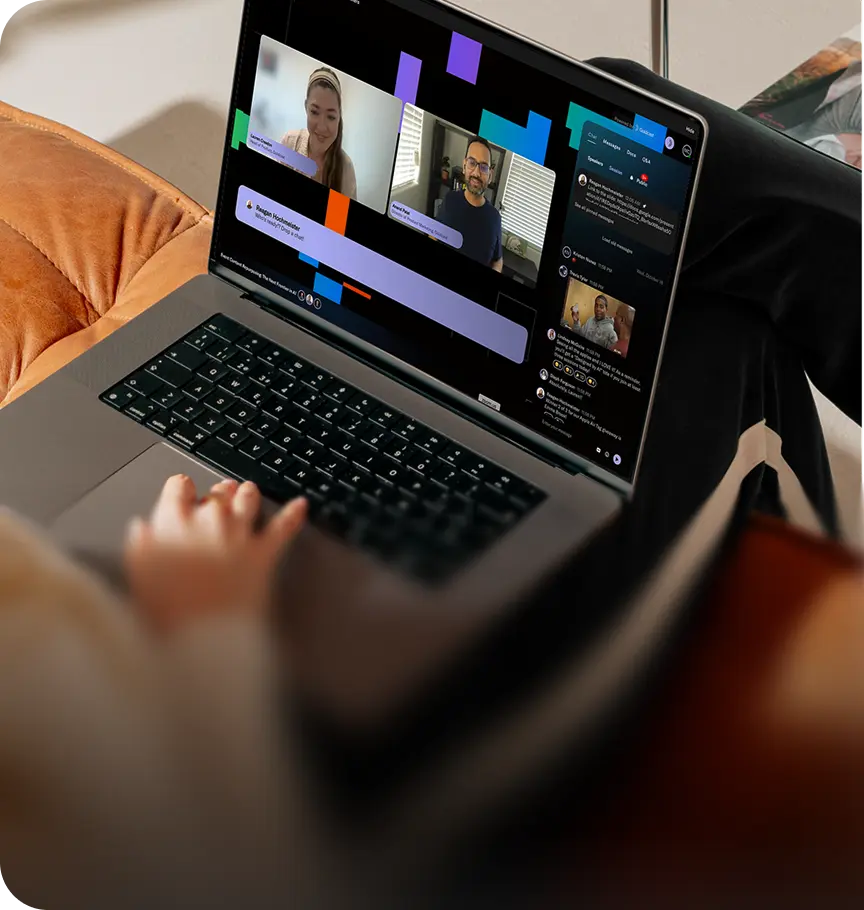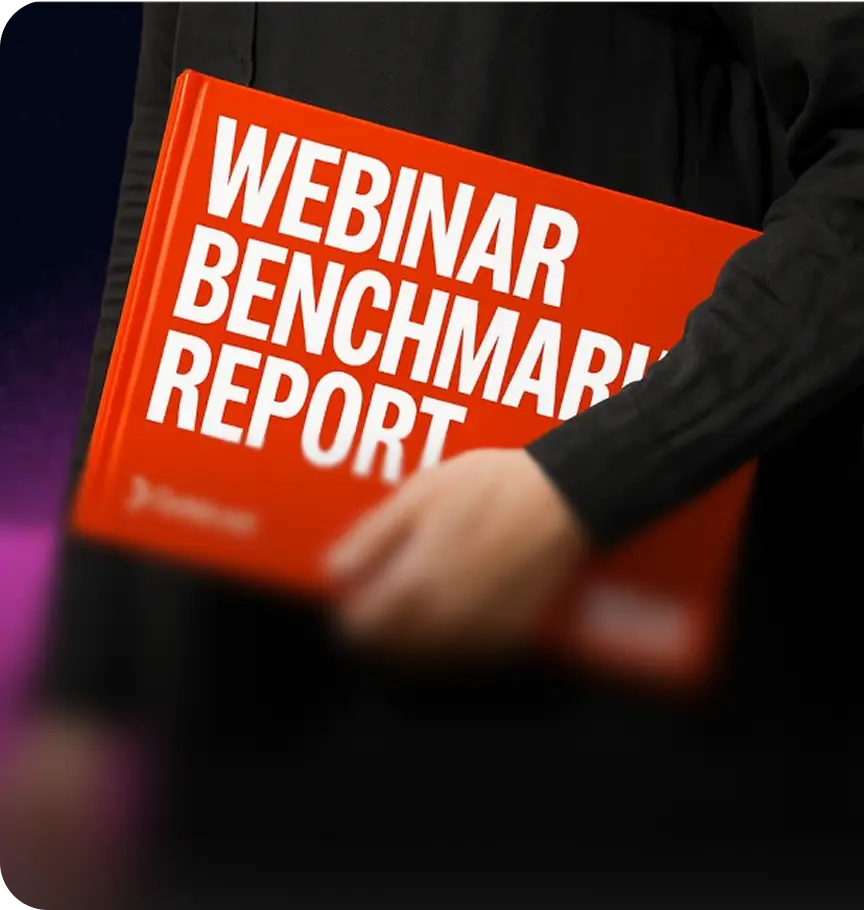5 Video Marketing Trends to Fine-Tune Your B2B Strategy

Maximize Your Marketing ROI
Join 10,000 other marketers already getting the best tips on running engaging events that boost pipeline and create raving fans.
Video marketing in B2B isn’t just about explainer videos and product demos. As B2B audiences behave more and more like B2C audiences, a growing number of Chief Marketing Officers (CMOs) are executing a video-first strategy to fuel their multichannel campaigns.
But which strategies actually work? And how can you position your brand to be one step ahead when the next wave of video trends hits? In this article, we’re sharing top trends and strategies to level up your video marketing.
Tune into all things B2B marketing. Binge our Coffee Corner series on-demand starting with this episode all about the latest best practices for video marketing.
5 of the top video marketing trends for B2B marketers
When building your B2B video marketing strategy, it helps to know what trends are on the horizon. Here are the top five video marketing trends, plus tips for how to use them in your strategy.
1. The rise of AI in video marketing
Artificial intelligence (AI) isn’t perfect, but when it comes to video, it has definitely leveled the playing field. According to data, 85% of marketers say generative AI has changed the way they create content and 62% say it’s important to their marketing strategy.
With the right video AI tools, you don’t need a giant team to execute content marketing tasks like:
- Repurpose videos into clips, blog posts, social content, and emails
- Generate multiple assets from one video
- Combine video and text for media-rich content experiences
- Customize repurposed content with your branding
- Format content for digital marketing channels
- Add transcripts, captions and translations
“We have a multi-pronged approach to using AI,” explains Amrita Mathur, VP Marketing at Clickup. For expert marketers like Amrita, it’s all about getting more value from the assets you already have. Here’s how she structures her video marketing strategy:
- Brainstorming and producing content
- Quickly finding the best clips within longer videos
- Bringing more video production in-house to scale faster
From outsourcing your video transcripts to repurposing videos into multimodal content, AI can take over several time consuming tasks for you.
“Gone are the days when people had to have technical skills or video editing skills. With all the AI tools around, so much of that [editing] can be done in a pretty self-sufficient way.” — Amrita Mathur, VP, Marketing, Clickup
2. Short-form videos continue to dominate on social media
From Instagram Reels to YouTube Shorts, social media marketing is a moving target. But short-form content continues to hit the bull’s eye.
Like many marketers, Chief Marketing Officer at Marqeta, Karna Crawford, doesn’t feel like she’s cracked the B2B social media code just yet. But with the rapid rise of short videos, she and her team are leaning into everything they do with a social first mindset.
“I’m taking a page out of my B2C book on this one. Connecting with people is often about connecting with culture. And inB2B, who you're selling to is still people, so there are still ways for us to connect to culture. We just have to think about it differently. That becomes increasingly true and relevant on social,” explains Karna in a recent episode of CMO Diaries.
Data from Wyzowl shows that the top four most popular video marketing platforms for marketers are YouTube (90%), Facebook (86%), Instagram (79%) and LinkedIn (76%). For B2B marketers, that last one is critical. And with the rise of B2B influencers, even TikTok is finding its place in the B2B marketing strategy. But no matter where you choose to invest your efforts on social media, short snackable content is on the rise.
According to the data, marketers use the following lengths for their short-form video assets:
- 30-60 seconds (39%)
- 1-2 minutes (28%)
- 30 seconds or less (18%)
- 2-3 minutes (10%)
- 3 minutes or more (5%)
With the right clip on the right social media channel, marketers like the team at Aspencore are seeing major upticks in engagement. In fact, a single video post crafted in Content Lab had more engagement than a 39-post campaign with only graphics. “The engagement from one post versus an entire campaign was incredible. We also got a lot of re- shares and whatnot,” explains Kristen Nuñez, Global Event Manager with AspenCore.
3. Serialized content becomes the norm
Despite the rise in short-form video content, there’s still a place for long-form videos in the B2B marketing playbook. Data from Wistia shows that longer videos usually get more clicks per page visit, suggesting that viewers that watch your long-form videos are more likely to engage with the rest of your content, and may have higher intent to convert.
And we’re not just talking about customer testimonials and product tutorials. Some of the best ways to position your long-form content to stand out is through leveraging recurring formats, like event series and podcasts.
“If you look at where the entire consumer industry has headed over the past 10 years, it’s been this evolution towards building bingeworthy content and getting someone to subscribe to and consume content as part of their weekly, monthly, or daily routine,” says Ian Faison, CEO & Founder at Caspian Studios.
Some examples of a recurring event series could include:
- Thought leadership series: Organize a series of expert panels to discuss industry trends, best practices, and thought-provoking topics, or take it one-on-one with a fireside chat framework.
- Training and workshop series: Conduct a series of educational workshops and/or live video training sessions to provide real-time value to your audience.
- Product launch series: Introduce a series of events to launch, showcase, and demonstrate new products or features.
- Networking and meetup series: Host a regular series of networking events to foster connections and reinforce your role in the community.
- Customer success series: Feature a recurring series of customer success stories and case studies to demonstrate the real day-to-day impact of your products.
With a regular cadence for your long-form video content, you can drive lead generation, gain increased audience loyalty over time, and dramatically scale your reach.
"It's built-in distribution which is genius. If you have a webinar series, [you can say] if you like this discussion, join us for the next one a month from now, two weeks from now, next week, whatever it is," says Arthur Castillo, Head of Dark Social & Evangelism at Chili Piper.
With the right video marketing tools, it’s easy to hit multiple long-form formats with the same ‘content creation stone’. For example, the team at BambooHR regularly sees 1.4K registrations and 400+ live attendees for its events, which the marketing team then transforms into episodes for the brand’s HR Unplugged podcast.
4. Video in blog posts, emails, and more
With the rise of AI, comes a sea of generic content.
To capture your viewer’s attention, experts predict an increased focus on authenticity. One of the most effective ways to do that is by giving your blog posts, emails, and other traditionally text-based formats, a human face with video.
From a single long-form video, you can create:
- Tailored outreach emails
- Vertical videos for social media platforms
- Engaging audiograms
- SEO-optimized blog post embeds
- On-demand content
- Event promos
- Event summaries
- Content for video ads
By linking your video strategy with the rest of your multimodal content strategy, you can save countless hours (and dollars) by creating multiple types of content from the same video. And the best part? This strategy also helps you harness the best of two other video trends: user-generated content (UGC) and video and video search engine optimization (SEO), a.k.a. video SEO.
According to research, Gen Z and millennial generations watch more UGC than both Gen X and Boomers. And according to a recent analysis of Google’s ranking criteria, including videos on your blog posts and webpages can improve dwell time and help boost your rankings on the search engine results page (SERP).
5. Silent videos
According to research from LinkedIn, 44% of users watching video on a laptop or desktop do so with their sound off. This number is even higher among mobile users, with 63% saying their sound is usually off, including 21% of mobile B2B video viewers who say their sound is permanently turned off.
That’s where features like subtitles, translations, and audiograms can be extremely effective for increasing leads and engagement. An audiogram is a visual representation of audio content that combines images, text, subtitling and translations to create an accessible and engaging experience for audiences scrolling on social media.
With the right video platform, you can repurpose your recordings into engaging audiograms in just a few easy steps:
- Choose the perfect soundbite from your long-form video or audio recording
- Automatically format to meet key technical details, such as file sizes and snippet lengths
- Incorporate visual elements like speaker headshots and custom backgrounds
And with done-for-you translations and captioning, you can enhance the accessibility of your videos while making it easier to connect with target audiences that have increasingly short attention spans.
Video creation, made easy.
According to recent data, the average content team has only 1 to 5 people responsible for an average of five formats. That’s a lot of pressure on not a lot of people. By making a bigger splash with the video assets you already have, you can keep up with the internal demand for content, while freeing up more time for strategic projects.
Start by integrating your event marketing with your video marketing strategy. By creating authentic and interactive video recordings from your events, then using your engagement metrics to guide your strategy, you’ll know which messages resonate most with your target audience and accounts. And with built-in video production tools, you can harness high-quality source material to create multiple video formats for other channels.
Goldcast combines events with video marketing using AI. With features designed to help you run high-quality events packed with shareable moments, and make them available on-demand, you’ll have everything you need to execute a high-ROI video marketing strategy.
Sign up for the freemium version of Content Lab and upload one full hour of video per month. Or book a personalized demo of Goldcast today and start building your event-to-video content pipeline.
Transform Your Video Marketing with AI
Stay In Touch
Platform
Resources
© 2025 Copyright Goldcast, Inc. All rights reserved.





 Upcoming Events
Upcoming Events Event Series
Event Series On-Demand Events
On-Demand Events

